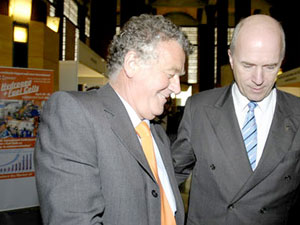Arno's EnergyIdeas (26)
The Electric Car: Between Euphoria and / or irrational act
Huge was the euphoria in the media, when BMW's Board member Dr. Norbert Reithofer, Chairman of the Board of Management of BMW AG and Tuomo Hatakka, CEO of Vattenfall, started a "remarkable project“ in Berlin. What was all the fuss about? The two „forerunners“ introduced one of 50 recharging points, which will supply 50 electric Mini cars with electricity sometime in the future. One charge will last for a range of 250 km - then the vehicles have to be reloaded. In response, Daimler is teaming up a similar project in London with e-vehicles based on their Smart models. And all - of course - free of pollutants, or attend the creative diction: local pollution-free. That sounds good, though...

GM Europe chief Carl-Peter Forster (right), chairman of the supervisory
board of Adam Opel GmbH, receiving a briefing from the author about the
HANNOVER FAIR. |
Well, then, congratulations to the electricity suppliers in the world, for
them this is a gift of a completely new market, which brings revenue and
profit. However, what does it also bring? That, as always in life
"depends" on the strategy. In this case it depends on how the electricity
is being generated for tue use in the electric vehicles to support clean
mobility. It is known, that coal-fired power plants - not only in Germany,
but worldwide - are by far the largest carbon dioxide producers. Depending
on the source and way of calculation, the new advanced e-vehicles,
although small and light, still generate over 160 grams of carbon dioxide
per kilometer, far more than what similar vehicles available at the car
dealers with "clean" fossil combustion engines blow in the streets.
A few days later, car maker Opel, regardless of being threatened by the
liquidity shortage
financial crisis of the U.S. parent company General Motors (GM), presented
the development of its promising fuel-cell propulsion vehicle in Berlin as
well. GM Europe President Carl-Peter Forster and the German Federal
Transport Minister Wolfgang Tiefensee (SPD) displayed the “next
generation” of hydrogen-powered cars: the HydroGen4 . Also on this
occasion the question of the origin of the hydrogen was again not being
asked. Noteworthy is also the "expert" hyphen in: "Hydrogen- and Fuel
Cells" on the homepage of the Ministry of Transport, Building and Urban
Affairs (http://www.bmvbs.de). Good to know and now virtually on the
record – that there are hydrogen cells existing. Many believe in it
anyway.
As part of the National German Innovation Program, hydrogen and fuel cell
technology is supported by the Federal Ministry of Transport with 500
million Euro (...over a period of ten years) to: "... maintain the German
advance in these technologies..." Here we (Germany) are, according to the
Ministry on its homepage, already very well positioned. Now it will also
be the subject of long-term battery technology and market research and
preparation programes in this field are going to be coordinated. With the
Integrated Energy and Climate Change Program IEKP the theme of "Electric
Mobility" will close this gap. It remains exciting were the origin of the
primary energy for the mobility in our country is going to come from.
What has been achieved so far? In 2007 in Germany "exemplary" 87 billion
kWh electricity were produced from renewable energies. This corresponded
to a share of just 14 percent on total gross electricity consumption. In
the case of electricity, the power of coal and lignite underwent a
significant growth in 2007: The power generation based on coal rose by 5.2
percent to 145 billion kWh, in the lignite power plants were generating
3.3 percent more electricity than in 2006. Overall, coal supplied 301
billion kWh of electricity. ´That means, 47 percent of the electricity
comes from coal in Germany. Nothing to be proud of, really,
Nuclear power plants supplied 140.5 billion kWh in 2007 - almost 16
percent less electricity than in previous year. After temporary closure of
up to six of the 17 German nuclear power plants, in the end of 2007, again
14 plants resumed in operation. The proportion of nuclear power in gross
electricity generation in Germany fell to 22.1 percent in 2007 and is now
behind the shares of coal as a primary energy for electricity production.
The installed capacity for wind power rose in 2007 by about 1.670 MW to
around 22.290 MW. Overall, at year-end in Germany were estimated 19.570
wind turbines in operation. Electricity generation from wind power grew by
nearly 29 percent to 39.5 billion kWh. An impressive number, however, for
comparison: The electricity exports to countries like the Netherlands,
Switzerland and Austria amounted to 63.3 billion kWh in the same period.
From biogenic energy sources, including the prorated production in garbage
power plants (biogenic waste), 24 billion kWh of electricity were produced
in 2007 in Germany. Even the electricity generation from photovoltaic
contributed approximately remarkable three billion kWh to the production
of gross electricity. The electricity in hydroelectric plants, including
those pumped to water reservoirs, amounted to 27.5 billion kWh. Of these,
20.7 billion kWh were calculated as being with regenerative effect.
However: Not only in Germany, the whole, "regenerative" electricity
generated, is forced,
by law, as 50-Hz alternating current (AC) to the low, medium or high
tension grid, to then
"somewhere", indefinable appearing at the power sockets again. Where and
how exactly this happens, nobody can say today seriously. Furthermore, the
regenerative electricity generated is following the whole "Conversion
loss chain", of the electricity network supply to the consumer, be it for
mining, industry and SME`s, households or even transportation. So around
30 percent of the primary energy disappear quickly, before it is arriving
to the respective points of use. This conversion losses alone amount to
more than 1.7-fold (171 percent) of total the energy consumption in German
households.
My question now: Why are there little or no activities towards a
decentralized energy system - not only for transportation services; where
the energy is produced intelligently, directly at the point of usage,
without much conversion and transportation losses? Especially since
batteries can only be charged with DC . By now, to jump upon the
bandwagon, to follow the existing path, to rely again on a given network
structure will lead again to dangerous monopolistic dependencies. Which
will probably be questioned again in 40 to 50 years earliest. If it is not
too late than...
Links to news:
http://www.opel.de/shop/technics/hydrogen4/index.act
http://www.bmvbs.de/Klima_-Umwelt-Energie/Mobilitaet-Verkehr/Technologien-Energie-,2987.1059206/Elektromobilitaet.htm
https://www.hydrogenambassadors.com/background/strombilanz.php
Image:
GM Europe chief Carl-Peter Forster (right), chairman of the supervisory
board of Adam Opel GmbH, receiving a briefing from the author about the
HANNOVER FAIR.
(Photo: Julio E. Foster, Aragon Grafico, Zaragossa, Spain)
Date: 02.12.2008 |
